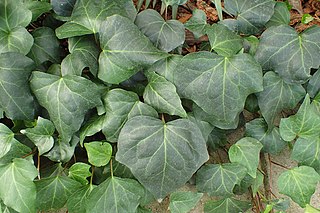
Hedera, commonly called ivy, is a genus of 12–15 species of evergreen climbing or ground-creeping woody plants in the family Araliaceae, native to Western Europe, Central Europe, Southern Europe, Macaronesia, northwestern Africa and across central-southern Asia east to Japan and Taiwan. Several species are cultivated as climbing ornamentals, and the name ivy especially denotes common ivy, known in North America as "English ivy", which is frequently planted to clothe brick walls.

Hepatica is a genus of herbaceous perennials in the buttercup family, native to central and northern Europe, Asia and eastern North America. Some botanists include Hepatica within a wider interpretation of Anemone.

Lespedeza is a genus of some 45 species of flowering plants in the pea family (Fabaceae), commonly known as bush clovers or Japanese clovers (hagi). The genus is native to warm temperate to subtropical regions of eastern North America, eastern and southern Asia and Australasia.

Chamaecyparis obtusa is a species of cypress native to central Japan in East Asia, and widely cultivated in the temperate northern hemisphere for its high-quality timber and ornamental qualities, with many cultivars commercially available.

Elaeagnus is a genus of about 50–70 species of flowering plants in the family Elaeagnaceae. Species of the genus are commonly known as silverberry or oleaster,

Ulmus davidiana var. japonica, the Japanese elm, is one of the larger and more graceful Asiatic elms, endemic to much of continental northeast Asia and Japan, where it grows in swamp forest on young alluvial soils, although much of this habitat has now been lost to intensive rice cultivation.

Euonymus fortunei, the spindle, Fortune's spindle, winter creeper or wintercreeper, is a species of flowering plant in the family Celastraceae, native to east Asia, including China, Korea, the Philippines and Japan. E. fortunei is highly invasive and damaging in the United States, causing the death of trees and forest in urban areas.

Anemone hepatica, the common hepatica, liverwort, liverleaf, kidneywort, or pennywort, is a species of flowering plant in the buttercup family Ranunculaceae, native to woodland in temperate regions of the Northern Hemisphere. This herbaceous perennial grows from a rhizome.

Boenninghausenia is a monotypic genus of flowering plants in the family Rutaceae. The sole species is Boenninghausenia albiflora, which occurs in Bhutan, Nepal, Pakistan, Kashmir, India, Indonesia, Philippines, Myanmar, Thailand, Laos, North Vietnam, China and Japan.

Pyrenaria microcarpa is an evergreen plant in the family Theaceae. It is native from southern mainland China, east to Taiwan, and south to Myanmar and Vietnam.

Pyrenaria buisanensis is a species of tea endemic to Taiwan. It was first described by the Japanese botanist Shun-ichi Sasaki in 1931, but the herbarium specimens were lost and the species identity remained dubious until a 2004 publication that reported its rediscovery and reclassified it as a species of Pyrenaria. Its status remains controversial, with some sources including it in Pyrenaria microcarpa as P. microcarpa var. ovalifolia.

Abelia chinensis, commonly known as Chinese abelia, is a species of flowering plant in the honeysuckle family Caprifoliaceae. It is a semi-evergreen, densely branched shrub with dark green foliage.
Astilbe glaberrima, called the florist's spiraea and smooth rock astilbe, is a species of flowering plant in the genus Astilbe, native to Yakushima Island, Japan. Some authorities have it as a subspecies of Astilbe japonica, Astilbe japonica subsp. glaberrima. Its dwarf variety Astilbe glaberrima var. saxatilis has gained the Royal Horticultural Society's Award of Garden Merit.

Eriocapitella is a genus of flowering plants in the buttercup family Ranunculaceae. Plants of the genus are native to Asia. The generic name Eriocapitella roughly translates to "growing in a small woolly head", which refers to the hairy ovary and fruit of some members of the genus. Cultivated plants are commonly known as fall-blooming anemones.

Eriocapitella tomentosa, a species of flowering plant in the buttercup family Ranunculaceae, is native to Asia. The specific epithet tomentosa means "thickly matted with hairs, tomentum (padding)". In Chinese, a common name is da huo cao (大火草), which means "big fire grass" or "great fireweed".

Eriocapitella japonica is a species of flowering plant in the buttercup family Ranunculaceae. The specific epithet japonica means "from Japan", which is a misnomer since the species is introduced in Japan. It is native to China, Taiwan, and Vietnam.

Dischidia formosana is a species of plant in the genus Dischidia native to Taiwan and the Japanese chain of Ryukyu Islands that stretch southwest from Kyushu to Taiwan. Like other Dischidia it has a climbing growth habit, producing smooth, round leaves and tiny white flowers. Though not particularly rare in Taiwan, the species is on the Japanese Red List as a critically endangered plant.

Gleditsia japonica, the Japanese locust, is a species of flowering plant in the family Fabaceae, native to the eastern Himalayas, central and southern China, Manchuria, Korea, and central and southern Japan. It is used as a street tree in a number of cities in China and Europe.
















